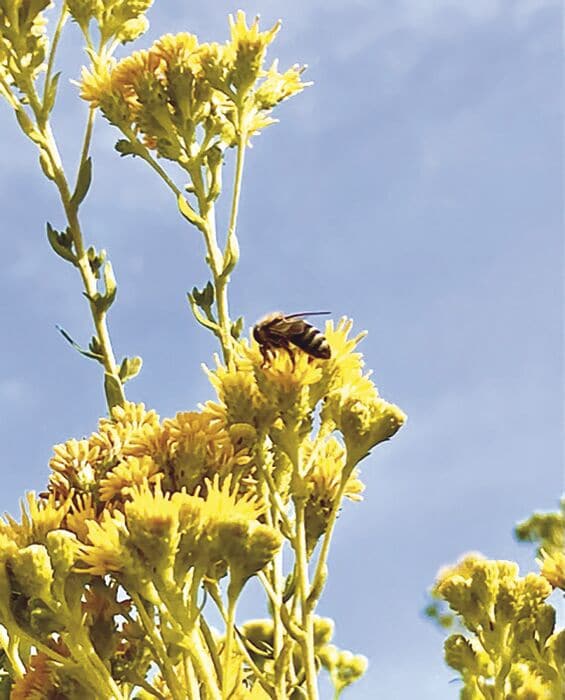Welcome to the Pollinator garden.
Pollinator gardens are the best way to make friends with the birds, bees, and butterflies that live in Malibu. Not only do they provide habitat and nectar for nourishment but also pollen—the tiny yellow grains at the center of every flower—that sticks to the feet and bodies of bees, birds, and butterflies. When they zoom from plant to plant in your garden, they deposit pollen wherever they go. Pollination is essential for making new seeds and fruit. We provide pollinators with nourishment. In return, they give us food.
Fun fact: Bees pollinate 80 percent of the world’s plants.
In Malibu, November and December are great times to plant pollinator gardens. The winter rains will give the seed a great start. In dry years, it is necessary to provide supplemental water.
Where to begin? Start by eliminating all pesticides from your garden. Antonio Sanchez, the manager of the Santa Monica Mountains National Recreation Area native plant nursery, said the most critical element is to buy plants that are grown without pesticides.
A pollinator garden can be any size: as small as a planter on your terrace or as large as a lawn. As you want to select the right plants for the area, it is important to analyze the growing conditions. Look around. How much sun hits your ideal spot? What kind of soil does it have? Does water drain through it, is it humus-rich or is it a challenge for your shovel? Will your hose reach the new garden? Even though many native plants are drought tolerant, they require moderate water until they have settled in. If your garden is in view of your home or outdoor sitting area, you will be rewarded with a show all year long. A hummingbird might even buzz you.
Next, give the birds, bees, and butterflies something yummy to eat just as you would your cat or dog and a water source such as a fountain or shallow birdbath.
For the greatest success, Bob Sussman, owner of Moorpark’s Matilija Native Plant Nursery, recommended buying plants native to one’s area. Native pollinators that are easy to grow in a Malibu shade garden include: red-pink blossomed hummingbird sage (Salvia spathacea) and evergreen arum root (Heuchera maxima), Sussman described. Native to the Channel Islands, Heuchera maxima has white blossoms that sparkle in the shade while Heuchera, “Santa Ana Cardinal,” has bright red flowers.
For the sunny garden, Sussman suggested yarrow: Achillea millefolium with white flowers and Achillea millefolium “Island Pink”; Lilac verbena; Verbena lilacina, “De La Mina”; red flowering California fuschia (Zauschneria californica); and Z. californica, “Catalina,” which are hummingbird favorites. I can attest to the ease of growing achillea. Achillea millefolium and A. millefolium, “Island Pink,” have provided a lovely display in my seeded meadow. The butterflies and bees are attracted to their bloom while the birds swoop in for the late season seed heads.
My biggest gardening challenge? My Airedale, Eloise. She has an uncontrollable appetite for Verbena, “De La Mina.”
Native pollinator evergreen shrubs that are easy to grow include sage such as the fragrant Salvia “Allen Chickering” and the favorite Ceanothus, “Concha.” One evergreen shrub I would like to find a place for is island bush mallow (Lavatera assurgentiflora). Evergreen with showy magenta flowers, it grows to about 10 feet and attracts both hummingbirds and bees.
If you want a more rustic look, bee and hummingbird favorites buckwheat (Eriogonum fasciculatum), coastal goldenbush (Isocoma menziesii), and bladderpod (Isomeris arboreus) are a sure bet that require little water once established. Ed Gil-Gomez of Malibu’s Garden Culture suggested bladderpod to stabilize slopes. Take a walk in Legacy Park the next time you are shopping in central Malibu. The goldenbush is brilliantly yellow and buzzing with happy bees.
Should you have a large area in which you want to start a drought tolerant, native meadow, S & S Seeds in Carpinteria grows a colorful selection of wildflower seed including favorites such as achillea, California poppies, lupine, linum, and baby blue eyes. You can make your own mix or select one of their mixtures of annual and perennial California native wildflower natives. The minimum order is $150.
Planting wildflowers from seed is not as simple as tossing handfuls of seed into the wind. Invasive weeds are a constant challenge. The birds you want to welcome to the garden will frustrate you by picking out the freshly sown seed.
Begin by clearing the land, either by sod removal or smothering the weeds with layers of newspaper or black plastic. Avoid using herbicides or adding soil amendments as wildflowers thrive in poor soil. Rough up the surface, spread the seed and then cover the seed with a thin layer of soil. Gently water the seeds, but be careful to avoid rivulets that could wash them away. Beware that during the first few years of a pollinator garden it will be necessary to remove weeds. Keep an eye out, especially for wild arugula.
Fun fact: One of every three or four bites of food you eat is thanks to the honeybee.





